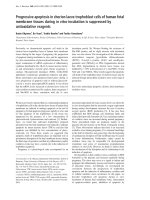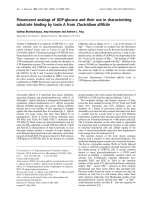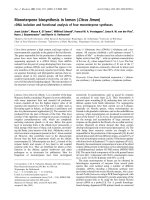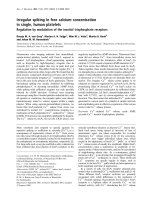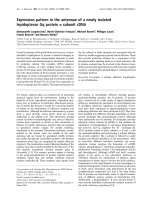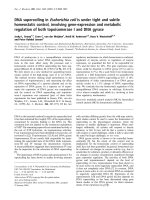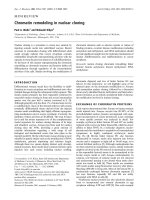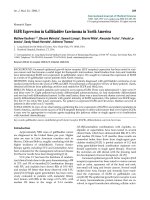Báo cáo y học: "Insulin-related decrease in cerebral glucose despite normoglycemia in aneurysmal subarachnoid hemorrhage" doc
Bạn đang xem bản rút gọn của tài liệu. Xem và tải ngay bản đầy đủ của tài liệu tại đây (303.38 KB, 7 trang )
Open Access
Available online />Page 1 of 7
(page number not for citation purposes)
Vol 12 No 1
Research
Insulin-related decrease in cerebral glucose despite
normoglycemia in aneurysmal subarachnoid hemorrhage
Florian Schlenk
1
, Daniela Graetz
1
, Alexandra Nagel
1
, Maren Schmidt
2
and Asita S Sarrafzadeh
1
1
Department of Neurosurgery, Charité Campus Virchow Medical Center, Augustenburger Platz, 13353 Berlin, Germany
2
Department of Anaesthesiology and Intensive Care Medicine, Charité Campus Virchow Medical Center, Augustenburger Platz, 13353 Berlin,
Germany
Corresponding author: Asita S Sarrafzadeh,
Received: 21 Aug 2007 Revisions requested: 5 Oct 2007 Revisions received: 1 Dec 2007 Accepted: 24 Jan 2008 Published: 24 Jan 2008
Critical Care 2008, 12:R9 (doi:10.1186/cc6776)
This article is online at: />© 2008 Schlenk et al.; licensee BioMed Central Ltd.
This is an open access article distributed under the terms of the Creative Commons Attribution License ( />),
which permits unrestricted use, distribution, and reproduction in any medium, provided the original work is properly cited.
Introduction Hyperglycaemia following aneurysmal
subarachnoid hemorrhage (SAH) is associated with
complications and impaired neurological recovery. The aim of
this study was to determine the effect of insulin treatment for
glucose control on cerebral metabolism in SAH patients.
Methods This prospective, nonrandomized study was
conducted in 31 SAH patients in an intensive care unit (age 52
± 10 years, World Federation of Neurological Surgeons grade
2.9 ± 1.6). A microdialysis catheter was inserted into the
vascular territory of the aneurysm after clipping. Blood glucose
levels above 140 mg/dl were treated with intravenous insulin
and the microdialysates were analyzed hourly for the first 12
hours of infusion.
Results No hypoglycaemia occurred. Twenty-four patients were
treated with insulin for glucose control. Higher age and World
Federation of Neurological Surgeons score were risk factors for
need for insulin treatment (P < 0.05). Although blood glucose
remained stable after initiation of insulin infusion, insulin induced
a significant decrease in cerebral glucose at 3 hours after onset
of the infusion until the end of the observation period (P < 0.05),
reflecting high glucose utilization. The lactate:pyruvate ratio and
glutamate did not increase, excluding ischaemia as possible
cause of the decrease in glucose. Glycerol tended toward
higher values at the end of the observation period (9 to 12
hours), reflecting either tissue damage after SAH or the
beginning of cellular distress after insulin infusion.
Conclusion Higher SAH grade was among the risk factors for
need for insulin. Intensive glycaemic control using insulin
induced a decrease of cerebral glucose and a slight increase in
glycerol, though blood glucose remained normal. Future studies
might detect relevant metabolic derangements when insulin
treatment starts at low cerebral glucose levels, and may allow us
to design a strategy for avoidance of insulin-induced metabolic
crisis in SAH patients.
Introduction
Hyperglycaemia on admission and elevated blood glucose lev-
els during the first week after SAH are common and well
established as predictors of poor outcome [1,2]. Although
preventative glycaemic control with levels not substantially
exceeding 110 mg/dl reduced mortality during intensive care
by more than 40%, threshold glucose levels deemed to
require treatment with insulin in patients with aneurysmal sub-
arachnoid haemorrhage (SAH) vary considerably [1-3].
One of the main advantages of cerebral microdialysis (an
established neuromonitoring technique for analyzing cerebral
extracellular fluid) is its ability to assess cerebral delivery and
utilization of glucose, the main source of energy to the brain,
online in the neurointensive care unit [4-6]. Data from patients
with traumatic brain injury (TBI) [7] demonstrated a clear rela-
tionship between low cerebral microdialysis glucose levels
and unfavourable outcome. Similarly, in SAH lowered cerebral
glucose levels were accompanied by a severe metabolic
derangement [8]. Furthermore, targeted insulin therapy for glu-
cose control was shown to reduce cerebral extracellular glu-
cose and to increase markers of cellular distress in TBI [9].
Although treatment of hyperglycaemia improves outcome,
insulin might have harmful effects by inducing hypoglycaemia
DIND = delayed ischaemic neurological deficit; FDG = 2-deoxy-2-[
18
F]fluoro-D-glucose; PET = positron emission tomography; SAH = subarachnoid
haemorrhage; TBI = traumatic brain injury; WFNS = World Federation of Neurological Surgeons.
Critical Care Vol 12 No 1 Schlenk et al.
Page 2 of 7
(page number not for citation purposes)
and a metabolic crisis caused by low cerebral glucose levels.
Lacking the data to address this issue in SAH patients, we
conducted the present study to investigate the potentially
harmful effect of insulin treatment for blood glucose control on
cerebral metabolism in patients following aneurysmal SAH.
Materials and methods
Patient population
This study was approved by the local research ethics commit-
tee at Charité Virchow Medical Center, in accordance with the
Declaration of Helsinki as revised in Edinburgh in October
2000. Written informed consent was obtained from each
patient or their closest family relative.
Patient characteristics and management
This study forms part of an ongoing prospective study on cer-
ebral metabolism monitored by bedside microdialysis in aneu-
rysmal SAH patients. A total of 31 patients were enrolled, who
were admitted to the neurosurgical department of a university
hospital between August 2005 and June 2007 and who met
the following criteria: confirmation of SAH by head computed
tomography; presence of intracranial aneurysm(s), as demon-
strated by cerebral angiogram; and surgical therapy. All
patients considered surgical candidates were managed in
accordance with a uniform protocol detailed previously [5].
Depending on their neurological course, the patients were
classified as asymptomatic (n = 6) or as exhibiting symptoms
of acute focal deficit (AFND; n = 14) or delayed ischaemic
neurological deficit (DIND; n = 11), with detailed definitions
described previously [5]. Information compiled for each
patient included the following: haemodynamic parameters,
respiratory values, laboratory test results, fluid balance data
and chest radiograph findings. Glucose levels were targeted
to be under 140 mg/dl using intravenous insulin if necessary.
Routine glycaemic control consisted of blood glucose checks
every 4 hours (6 hours in patients without insulin treatment)
and goal-directed adjustment of insulin infusion by the bedside
nurse.
Bedside microdialysis
A microdialysis catheter (CMA 70; CMA Microdialysis, Solna,
Sweden; length 10 mm, molecular weight limit of 100 kDa)
was inserted immediately after aneurysm clipping into brain
parenchyma of the respective vascular territory of the aneu-
rysm (for instance, the right frontal lobe in patients with an
anterior communicating artery aneurysm). Care was taken to
avoid insertion into macroscopically lesioned brain tissue or
into an intracerebral haemorrhage. Catheters were perfused
with sterile Ringer's solution at a flow rate of 0.3 μl/min. On the
outlet tube, perfusates were collected in microvials,
exchanged hourly and analyzed immediately at bedside in a
mobile photometric, enzyme-kinetic analyzer (CMA 600; CMA
Microdialysis). The estimated recovery for the system is 0.65
to 0.72 [10]. Parameters of energy metabolism (glucose, pyru-
vate, lactate, lactate:pyruvate ratio), glycerol (a marker of cell
membrane degradation) and glutamate (a marker of ischae-
mia) were analyzed [6,11,12]. In a series of studies, changes
in the lactate:pyruvate ratio and glutamate were shown to indi-
cate early the onset of delayed neurological deterioration and
to be in good accordance with the clinical course of SAH
patients [4,5,11-15]. The lactate:pyruvate ratio was the best
metabolic prognostic marker of 12-month outcome in SAH
[16].
Microdialysis data are presented as microdialysate concentra-
tions. The occurrence of critical decreases in cerebral glucose
(defined as decrease to <0.6 mmol/l, corresponding to the
mean level minus 1 standard deviation of our asymptomatic
SAH patients [8]) was recorded.
Data analysis
All data were collected during days 1 to 10 after admission for
SAH. Between-group comparisons were performed using
Kruskal-Wallis one-way analysis of variance. Statistical analy-
sis of non-normally distributed sequential data over time was
performed using Wilcoxon signed-rank test. Correlations
between normally distributed interval-scaled data were calcu-
lated using Pearson's product-moment correlation coefficient.
Otherwise, Spearman's rank correlation coefficient was calcu-
lated. Data in the tables and text are expressed as mean ±
standard deviation if not specified otherwise. Differences were
considered statistically significant at P < 0.05. All statistical
analyses were conducted using SPSS 14.0 (SPSS Inc., Chi-
cago, IL, USA).
Results
Patient characteristics
Demographic and clinical characteristics of the 31 patients
are summarized in Table 1. Patients were classified as an insu-
lin treatment group (n = 24) and a noninsulin treatment group
(n = 7). All patients (n = 31) underwent early surgery (within
72 hours after initial bleeding). Age, admission World Federa-
tion of Neurological Surgeons (WFNS) score and Fisher score
were significantly higher in the insulin treatment group (Table
1).
Blood glucose and insulin treatment
In 92% of the insulin-treated patients, hyperglycaemia was
present on admission (86% in the noninsulin treatment group)
and in all patients on at least one of the following 10 days in
the intensive care unit. Continuous intravenous insulin treat-
ment started 2.6 ± 3.0 days after admission. The median
blood glucose at onset of insulin infusion was 142.0 ± 7.6 mg/
dl. No episodes of insulin-induced hypoglycaemia (lowest
value 80 mg/dl) occurred during 10 days after SAH. A critical
decrease in cerebral glucose (to <0.6 mmol/l) occurred in 19
patients (79%) of the insulin treatment group, beginning 99.1
± 54.4 hours after initiation of insulin infusion (duration 6.9 ±
11.6 hours) and in three patients in the noninsulin treatment
group. In older patients (P = 0.03) and males (P = 0.02), low
Available online />Page 3 of 7
(page number not for citation purposes)
cerebral glucose values during insulin infusion occurred more
frequently than in younger patients and females. There was no
difference in the incidence and duration of critically low cere-
bral glucose values (<0.6 mmol/l) between the insulin treat-
ment and noninsulin treatment groups.
Cerebral metabolic changes during insulin treatment
Results from Vespa and colleagues [9] in patients with TBI
showed that microdialysis glucose reached its nadir at 11 ± 1
hours after onset of insulin infusion. Hence, in the present
study the microdialysis parameters were analyzed hourly for
12 hours after initiation of insulin infusion. Interestingly,
although blood glucose remained stable after insulin onset,
cerebral glucose began to decrease significantly at 3 hours
after the start of infusion and remained low until the end of our
observation period (Figure 1). Extracellular values of pyruvate,
lactate and lactate:pyruvate ratio did not change during insulin
infusion (Figures 2 to 4). Glycerol, a marker of cellular mem-
brane degradation, tended toward higher values at the end of
the observation period (9 to 12 hours; Figure 5). This might
either reflect tissue damage after SAH or indicate cellular dis-
tress following insulin-induced decrease in cerebral glucose.
Extracellular concentrations of glutamate decreased during
insulin infusion (hours 6 to 12; P < 0.05), indicating that no
additional ischaemia was present during the observation
period (Figure 6). Furthermore, the decrease in glutamate
might reflect metabolic improvement caused by treatment of
hyperglycaemia.
Table 1
Patient characteristics
Characteristic Treatment group P
Insulin treatment (n = 24) No insulin treatment (n = 7)
Age (years) 54.0 ± 9.5 46.0 ± 8.7 0.04
Sex (male/female; n) 7/17 1/6 0.44
Clinical presentation (asymptomatic/AFND/DIND; n) 1/14/9 5/0/2 0.03
Admission WFNS score 3.3 ± 1.6 1.6 ± 0.8 0.02
I (n [%]) 5 (21) 4 (57)
II (n [%]) 4 (17) 2 (29)
III (n [%]) 2 (8) 1 (14)
IV (n [%]) 6 (25) 0 (0)
V (n [%]) 7 (29) 0 (0)
Fisher score 3.7 ± 0.6 3.2 ± 0.8 0.06
Time between SAH and surgery (hours) 14.5 ± 7.8 15.4 ± 7.9 0.72
Duration of microdialysis (hours) 192.6 ± 71.0 295.1 ± 66.4 0.87
Intensive care unit stay (days) 16.8 ± 10.4 12.8 ± 7.8 0.40
Characteristics of 31 subarachnoid haemorrhage (SAH) patients. Data are expressed as mean ± standard deviation or absolute number and
percentage; P values are given for between-group comparison of insulin-treated and noninsulin-treated patients (Kruskal-Wallis one-way analysis
of variance). WFNS, World Federation of Neurological Surgeons Grading of SAH [21]; AFND, acute focal neurological deficit; DIND, delayed
ischemic neurological deficit.
Figure 1
Course of blood and cerebral extracellular glucose during insulin infusionCourse of blood and cerebral extracellular glucose during insulin infu-
sion. Data are expressed as mean ± standard error of blood glucose
and hourly microdialysate concentrations from 24 patients treated with
continuous intravenous insulin. Blood glucose levels were not available
for every single hour from every patient (see text for details). Levels of
significance are indicated for comparison with microdialysate concen-
trations at the start of insulin infusion (Wilcoxon signed-rank test). **P <
0.01; *P < 0.05.
Critical Care Vol 12 No 1 Schlenk et al.
Page 4 of 7
(page number not for citation purposes)
Cerebral metabolic changes and clinical symptoms in
relation to insulin
It must be considered that a decrease in cerebral glucose
might not be caused by insulin treatment alone but can also
reflect an increased consumption or decreased delivery
caused by cerebral vasospasm. To evaluate whether the
occurrence of vasospasm led to reductions in glucose that
were independent of the use of insulin, we analyzed our data
according to the onset of DIND.
Eighty-two per cent of the DIND patients were treated with
insulin infusion (9/11), and in almost all of them (8/9) the insu-
lin infusion was started before the onset of DIND. Cerebral glu-
cose tended to decrease 1 day before clinical manifestation of
DIND (P = 0.068; Figure 7), suggesting that the decrease in
glucose may not be caused by DIND but possibly by insulin
infusion, which started in average 2 days before DIND. The
lactate:pyruvate ratio and glycerol level (not shown) did not
change during this short period of time; however, this is not
entirely unexpected (Figure 7).
Figure 2
Course of cerebral extracellular pyruvate during insulin infusionCourse of cerebral extracellular pyruvate during insulin infusion. Data
are expressed as mean ± standard error of hourly microdialysate con-
centrations from 24 patients treated with continuous intravenous insu-
lin. Levels of significance are indicated for comparison with
microdialysate concentrations at the start of insulin infusion (Wilcoxon
signed-rank test). (*)P < 0.1.
Figure 3
Course of cerebral extracellular lactate during insulin infusionCourse of cerebral extracellular lactate during insulin infusion. Data are
expressed as mean ± standard error of hourly microdialysate concen-
trations from 24 patients treated with continuous intravenous insulin.
Figure 4
Course of cerebral lactate/pyruvate ratio during insulin infusionCourse of cerebral lactate/pyruvate ratio during insulin infusion. Data
are expressed as mean ± standard error of hourly microdialysate levels
from 24 patients treated with continuous intravenous insulin. L/P,
lactate:pyruvate.
Figure 5
Course of cerebral extracellular glycerol during insulin infusionCourse of cerebral extracellular glycerol during insulin infusion. Data
are expressed as mean ± standard error of hourly microdialysate con-
centrations from 24 patients treated with continuous intravenous insu-
lin. Levels of significance are indicated for comparison with
microdialysate concentrations at the start of insulin infusion (Wilcoxon
signed-rank test). *P < 0.05; (*)P < 0.1.
Available online />Page 5 of 7
(page number not for citation purposes)
Discussion
The high incidence of hyperglycaemia identified in this study
confirms the need to study the effect of insulin in detail. In 77%
of the patients included in the study, insulin was necessary for
glycaemic control. There are two principal findings of this
study. First, older age and higher WFNS and Fisher scores
were risk factors for need for insulin treatment. Second,
although blood glucose remained stable during the first 12
hours of insulin infusion, cerebral glucose began to decrease
significantly at 3 hours after the start of infusion and remained
low until the end of the 12-hour observation period. The lac-
tate:pyruvate ratio and glutamate level did not increase,
excluding ischaemia as a possible cause of the decrease in
glucose. After 8 hours of insulin infusion, glycerol (a marker of
cell membrane degradation) increased, reflecting either tissue
damage after SAH or the beginning of cellular distress follow-
ing insulin-induced decrease in cerebral glucose.
The role of insulin in the metabolic processes of the brain
remains unclear, but recent studies in the human brain using
2-deoxy-2-[
18
F]fluoro-D-glucose (FDG) positron emission
tomography (PET) [17] indicated that despite an abundance
of insulin receptors in the brain tissue, brain glucose metabo-
lism is not sensitive to insulin in physiological concentrations.
Unexpectedly, in this study intracerebral glucose concentra-
tions decreased after insulin, although blood glucose levels
remained unaffected. This observation is supported by data
from TBI patients showing that intensive insulin therapy results
in a net reduction in microdialysis glucose and an increase in
both markers of cellular distress and oxygen extraction fraction
to near ischaemic levels, even in absence of profound hypogly-
caemia [9].
In our study, mean cerebral glucose concentrations did not fall
below a critical threshold during insulin infusion. However, the
marked decrease in cerebral glucose that could be observed
suggests that in patients already presenting low cerebral glu-
cose levels before onset of insulin infusion, cerebral glucose
concentrations could decrease to critically low levels and
compromise the cerebral energy metabolism substantially.
Therefore, in our view, monitoring of cerebral glucose, espe-
cially at the start of and during insulin treatment, is valuable.
This is even more the case in high-grade SAH patients as insu-
lin treatment mainly becomes necessary; these patients are
known to develop a deranged cerebral metabolism and unfa-
vourable outcome. Although metabolic disturbances (increase
in glycerol) could be observed even at normal blood and
cerebral glucose levels, future studies might detect a relevant
metabolic derangement when insulin is administered to
patients with cerebral glucose levels that are already critically
low. This might be relevant because it has been shown that
low cerebral glucose levels (<0.2 mmol/l) correlate with unfa-
vourable outcome in TBI patients [7].
Hyperglycaemia and insulin treatment
Hyperglycaemia is common in critically ill patients. After
stroke, the in-hospital mortality was shown to be lowest in nor-
moglycaemic patients (1.7%), twice as high in diabetes
patients (3%) and increased by a factor of 10 in patients with
stress-induced hyperglycaemia (16%) [18]. In the latter group,
insulin treatment became necessary thrice as frequently.
Because hyperglycaemia appears to be injurious in conditions
of brain ischaemia, the findings of others and our own group
Figure 6
Course of cerebral extracellular glutamate during insulin infusionCourse of cerebral extracellular glutamate during insulin infusion. Data
are expressed as mean ± standard error of hourly microdialysate con-
centrations from 24 patients treated with continuous intravenous insu-
lin. Levels of significance are indicated for comparison with
microdialysate concentrations at onset of insulin infusion (Wilcoxon
signed-rank test). *P < 0.05
Figure 7
Course of cerebral extracellular glucose and lactate/pyruvate ratio in insulin-treated SAH patients developing DINDCourse of cerebral extracellular glucose and lactate/pyruvate ratio in
insulin-treated SAH patients developing DIND. Data are expressed as
mean ± standard error of daily medians calculated from hourly meas-
ured microdialysate levels of glucose and lactate:pyruvate (L/P) ratio in
nine insulin-treated subarachnoid haemorrhage (SAH) patients devel-
oping delayed ischaemic neurological deficit (DIND). (*) indicates a
trend (P < 0.1) toward a decrease in cerebral glucose, comparing the
levels at 2 days and 1 day before onset of DIND (Wilcoxon signed-rank
test, P = 0.068).
Critical Care Vol 12 No 1 Schlenk et al.
Page 6 of 7
(page number not for citation purposes)
suggest that avoidance of hyperglycaemia should be a general
strategy in SAH patients [1,2,16,19,20]. However, until now it
was unclear whether this strategy could be endorsed for appli-
cation in patients with low extracellular glucose levels. Data
from TBI patients support the concern that a reduction in
serum glucose could create substrate limitation in the injured
brain [9]. In the present study, during continuous insulin
infusion, there was a decrease in cerebral glucose levels in
79% of patients, similar to the percentage previously observed
in TBI patients (79%) [9]. This decrease in cerebral glucose
was associated with deterioration in homeostasis of cerebral
metabolism in TBI patients.
Critically lowered cerebral glucose
No episodes of insulin-induced hypoglycaemia (lowest value
80 mg/dl) occurred during 10 days after SAH. It is difficult to
determine what level of glucose might be too low for adequate
brain function, especially because in these patients the
demand for energy may be increased regionally. Dynamic PET
scanning of labelled water (H
2
15
O) and deoxyglucose (
18
FDG)
has revealed regional differences in cerebral metabolic capac-
ity that may explain why cerebral cortex is more sensitive to an
impaired glucose metabolism than other brain regions such as
cerebellum [17]. It was shown that low cerebral glucose levels
(<0.2 mmol/l) correlate with unfavourable outcome in TBI
patients [7], which is supported by our clinical experience;
hence, the suggested levels of 0.6 mmol/l might serve as an
applicable threshold for a critical decrease in cerebral glucose
[8]. In most patients (insulin treated: 83%; noninsulin treated:
77%) critically low cerebral glucose values were identified, but
they occurred as late as 4.1 ± 2.3 days after the start of insulin
infusion. The long time interval (>4 days) and the lack of any
difference in their incidence between insulin-treated and non-
insulin-treated patients suggest that these low cerebral glu-
cose levels were unrelated to insulin treatment.
Limitations of this study
There are some limitations of the present study. Microdialysis
is a regional method, and the volume of brain tissue monitored
by the microdialysis catheter covers only a few millimeters
from the membrane. Incomplete recovery affects the meas-
ured absolute concentrations and impairs the comparison with
blood data [10]. Additionally, because blood glucose values
were monitored discontinuously and not hourly, like the micro-
dialysates, some effects of insulin on blood glucose might not
have been detected in these patients.
Our results support the view of Vespa and colleagues [9] that
forced normalization of elevated blood glucose using insulin
might be deleterious for brain glucose concentrations and pro-
voke further metabolic crisis. This, however, can only be eval-
uated in future studies; further research, ideally in combination
with PET or cerebral blood flow studies, might investigate
whether a normalization of critically low microdialysis glucose
levels can improve outcome in patients with cerebral lesions.
Conclusion
This study confirms that hyperglycaemia is a significant com-
plication in aneurysmal SAH. Higher SAH grade, Fisher score
and age were risk factors for need for insulin. Insulin treatment
for glycaemic control was safe with respect to blood glucose,
because no hypoglycaemia (<80 mg/dl) occurred. However,
insulin infusion induced a significant decrease in cerebral glu-
cose and an associated increase in glycerol, reflecting high
glucose utilization and possibly the beginning of cellular dis-
tress. Because slight metabolic disturbances could be
observed even at normal cerebral glucose levels, future stud-
ies might detect a relevant metabolic derangement when insu-
lin treatment starts at cerebral glucose levels that are critically
low (<0.6 mmol/l). This could be relevant because it was
shown that low cerebral glucose (<0.2 mmol/l) is associated
with unfavourable outcome in TBI patients [7]. Future, more
detailed studies are necessary to design optimized targeted
therapies to avoid an insulin-induced metabolic crisis in SAH
patients.
Competing interests
The authors declare that they have no competing interests.
Authors' contributions
FS participated in the design of the study and performed the
statistical analysis, created the tables and figures, and drafted
part of the manuscript. He also managed the microdialysis
monitoring and collected the microdialysis and blood samples
of patients 1 to 15. DG and AN managed the microdialysis
monitoring and ensured compliance with the study protocol in
the intensive care unit, collected the microdialysis and blood
samples of patients 16 to 31, and prepared the data for statis-
tical analysis. MS performed the neurointensive management
of the patients and guided the insulin treatment. AS conceived
of the study and, as the project leader, was responsible for the
design, coordination and data interpretation, and drafted part
of the manuscript.
Acknowledgements
The authors acknowledge the technical assistance of Sabine Seidlitz
and Jasmin Kopetzki and the support of the intensive care unit team.
Key messages
• Older age and higher WFNS and Fisher scores are risk
factors for need for insulin treatment in patients with
aneurysmal SAH.
• Insulin infusion appears to induce a decrease in cere-
bral extracellular glucose, even when blood glucose
remains within the normal range.
• Monitoring of cerebral metabolism during insulin treat-
ment in SAH is valuable because it allows one to detect
metabolic derangements that may occur, especially
when insulin treatment starts at low cerebral glucose
levels.
Available online />Page 7 of 7
(page number not for citation purposes)
References
1. Frontera JA, Fernandez A, Claassen J, Schmidt M, Schumacher
HC, Wartenberg K, Temes R, Parra A, Ostapkovich ND, Mayer SA:
Hyperglycemia after SAH: predictors, associated complica-
tions, and impact on outcome. Stroke 2006, 37:199-203.
2. Badjatia N, Topcuoglu MA, Buonanno FS, Smith EE, Nogueira RG,
Rordorf GA, Carter BS, Ogilvy CS, Singhal AB: Relationship
between hyperglycemia and symptomatic vasospasm after
subarachnoid hemorrhage. Crit Care Med 2005,
33:1603-1609. quiz 1623.
3. van den Berghe G, Wouters P, Weekers F, Verwaest C, Bruyn-
inckx F, Schetz M, Vlasselaers D, Ferdinande P, Lauwers P, Bouil-
lon R: Intensive insulin therapy in the critically ill patients. N
Engl J Med 2001, 345:1359-1367.
4. Hutchinson PJ, Gupta AK, Fryer TF, Al-Rawi PG, Chatfield DA,
Coles JP, O'Connell MT, Kett-White R, Minhas PS, Aigbirhio FI,
Clark JC, Kirkpatrick PJ, Menon DK, Pickard JD: Correlation
between cerebral blood flow, substrate delivery, and metabo-
lism in head injury: a combined microdialysis and triple oxygen
positron emission tomography study. J Cereb Blood Flow
Metab 2002, 22:735-745.
5. Sarrafzadeh AS, Sakowitz OW, Kiening KL, Benndorf G, Lanksch
WR, Unterberg AW: Bedside microdialysis: a tool to monitor
cerebral metabolism in subarachnoid hemorrhage patients?
Crit Care Med 2002, 30:1062-1070.
6. Ungerstedt U: Microdialysis: principles and applications for
studies in animals and man. J Intern Med 1991, 230:365-373.
7. Vespa PM, McArthur D, O'Phelan K, Glenn T, Etchepare M, Kelly
D, Bergsneider M, Martin NA, Hovda DA: Persistently low extra-
cellular glucose correlates with poor outcome 6 months after
human traumatic brain injury despite a lack of increased lac-
tate: a microdialysis study. J Cereb Blood Flow Metab 2003,
23:865-877.
8. Schlenk F, Nagel A, Graetz D, Sarrafzadeh AS: Hyperglycemia
and cerebral glucose in aneurysmal SAH. Intensive Care Med
2008 in press.
9. Vespa P, Boonyaputthikul R, McArthur DL, Miller C, Etchepare M,
Bergsneider M, Glenn T, Martin N, Hovda D: Intensive insulin
therapy reduces microdialysis glucose values without altering
glucose utilization or improving the lactate/pyruvate ratio
after traumatic brain injury. Crit Care Med 2006, 34:850-856.
10. Hutchinson PJ, O'Connell MT, Al-Rawi PG, Maskell LB, Kett-White
R, Gupta AK, Richards HK, Hutchinson DB, Kirkpatrick PJ, Pickard
JD: Clinical cerebral microdialysis: a methodological study. J
Neurosurg 2000, 93:
37-43.
11. Saveland H, Nilsson OG, Boris-Moller F, Wieloch T, Brandt L:
Intracerebral microdialysis of glutamate and aspartate in two
vascular territories after aneurysmal subarachnoid
hemorrhage. Neurosurgery 1996, 38:12-19. discussion 19–20.
12. Hutchinson PJ, al-Rawi PG, O'Connell MT, Gupta AK, Maskell LB,
Hutchinson DB, Pickard JD, Kirkpatrick PJ: On-line monitoring of
substrate delivery and brain metabolism in head injury. Acta
Neurochir Suppl 2000, 76:431-435.
13. Persson L, Valtysson J, Enblad P, Warme PE, Cesarini K, Lewen A,
Hillered L: Neurochemical monitoring using intracerebral
microdialysis in patients with subarachnoid hemorrhage. J
Neurosurg 1996, 84:606-616.
14. Enblad P, Valtysson J, Andersson J, Lilja A, Valind S, Antoni G,
Langstrom B, Hillered L, Persson L: Simultaneous intracerebral
microdialysis and positron emission tomography in the detec-
tion of ischemia in patients with subarachnoid hemorrhage. J
Cereb Blood Flow Metab 1996, 16:637-644.
15. Nilsson OG, Brandt L, Ungerstedt U, Saveland H: Bedside detec-
tion of brain ischemia using intracerebral microdialysis: sub-
arachnoid hemorrhage and delayed ischemic deterioration.
Neurosurgery 1999, 45:1176-1184. discussion 1184-1175.
16. Sarrafzadeh A, Haux D, Kuchler I, Lanksch WR, Unterberg AW:
Poor-grade aneurysmal subarachnoid hemorrhage: relation-
ship of cerebral metabolism to outcome. J Neurosurg 2004,
100:400-406.
17. Cranston I, Marsden P, Matyka K, Evans M, Lomas J, Sonksen P,
Maisey M, Amiel SA: Regional differences in cerebral blood
flow and glucose utilization in diabetic man: the effect of
insulin. J Cereb Blood Flow Metab 1998, 18:130-140.
18. Capes SE, Hunt D, Malmberg K, Pathak P, Gerstein HC: Stress
hyperglycemia and prognosis of stroke in nondiabetic and dia-
betic patients: a systematic overview. Stroke 2001,
32:2426-2432.
19. Lanzino G, Kassell NF, Germanson T, Truskowski L, Alves W:
Plasma glucose levels and outcome after aneurysmal sub-
arachnoid hemorrhage. J Neurosurg 1993, 79:885-891.
20. Scott JF, Robinson GM, French JM, O'Connell JE, Alberti KG, Gray
CS: Glucose potassium insulin infusions in the treatment of
acute stroke patients with mild to moderate hyperglycemia:
the Glucose Insulin in Stroke Trial (GIST). Stroke 1999,
30:793-799.
21. Drake C: Report of World Federation of Neurological Surgeons
Committee on a Universal Subarachnoid Hemorrhage Grad-
ing Scale. J Neurosurg 1988, 68:985-986.

